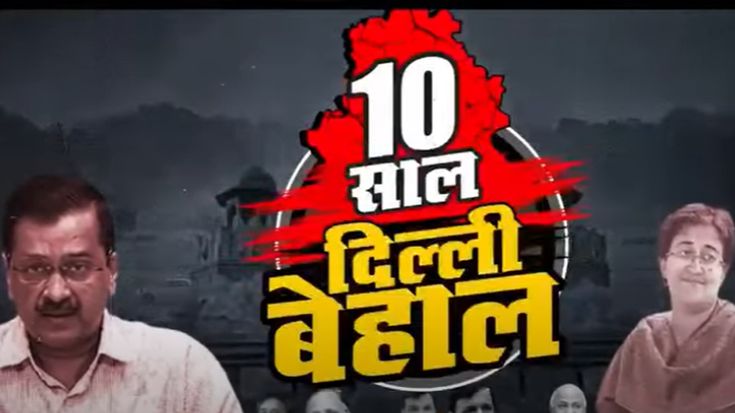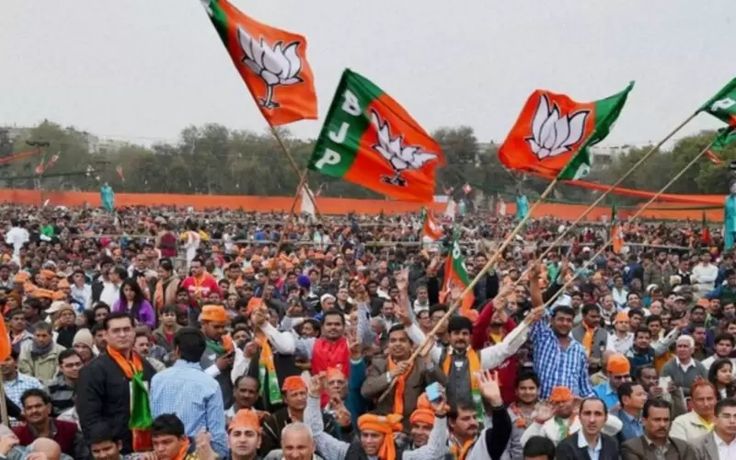Delhi elections-BJP manifesto
The BJP's 2025 Delhi manifesto highlights smart city development, economic growth, job creation, affordable housing, women's safety, education reforms, and healthcare access, aiming for a secure, sustainable, and global Delhi.
POLITICS
1/18/20256 min read


The Bharatiya Janata Party (BJP) has unveiled its manifesto for the upcoming Delhi Assembly elections, presenting a comprehensive plan aimed at fostering development and providing substantial support to the city's residents. Party President J.P. Nadda emphasized that this "Sankalp Patra" is a blueprint for a "developed Delhi," pledging to continue existing welfare schemes while introducing new initiatives to enhance the quality of life for Delhi's citizens.
Key Highlights of the BJP Manifesto:
1. Mahila Samridhi Yojana: Recognizing the pivotal role of women in society, the BJP promises a monthly aid of Rs.2,500 to women from economically weaker sections. This initiative aims to empower women financially and support their essential needs.
2. Affordable LPG Cylinders: To alleviate the burden of rising cooking gas prices, the manifesto offers LPG cylinders at a subsidized rate of Rs.500 for poor women. Additionally, one free cylinder will be provided during major festivals like Holi and Diwali, ensuring that celebrations are not hindered by financial constraints.
3. Healthcare Initiatives: The BJP plans to implement the Ayushman Bharat scheme in Delhi, providing health insurance coverage of Rs.5 lakh per family. An additional Rs.5 lakh coverage will be offered, totaling Rs.10 lakh per family, to ensure comprehensive healthcare access for all residents.
4. Senior Citizen Welfare: Understanding the needs of the elderly, the manifesto proposes increasing the monthly pension for senior citizens aged 60–70 years to Rs2,500, and for those above 70 years to Rs.3,000. This increment aims to provide better financial security and dignity to the senior population.
5. Atal Canteens: To combat hunger and malnutrition, the BJP intends to establish Atal Canteens in JJ clusters, offering nutritious meals at a nominal price of Rs.5. This initiative seeks to ensure that affordable and healthy food is accessible to the underprivileged sections of society.
Prospects of BJP's Victory in Delhi:
The BJP's manifesto reflects a deep commitment to the welfare of Delhi's residents, addressing critical areas such as women's empowerment, healthcare, and senior citizen support. By pledging to continue existing welfare schemes and introducing targeted initiatives, the party demonstrates a comprehensive approach to governance.
Given the BJP's track record of implementing welfare schemes and its focus on inclusive development, there is a strong possibility of the party resonating with the electorate. The emphasis on practical and impactful measures, such as subsidized LPG cylinders and enhanced pensions, showcases the party's dedication to addressing the immediate needs of the populace.
The party's clear vision and actionable plans position it favorably in the upcoming elections. The BJP's commitment to transparency, accountability, and holistic development aligns with the aspirations of Delhi's residents, potentially leading to a favorable outcome in the polls.
Ayushman Bharat Scheme
The Ayushman Bharat-Pradhan Mantri Jan Arogya Yojana (AB-PMJAY) is one of the world's largest government-sponsored healthcare schemes. It aims to provide accessible, affordable, and quality healthcare services to economically disadvantaged sections of society.
Key Features of the Scheme:
Financial Coverage: Each family is entitled to annual health insurance coverage of up to Rs.5 lakh for secondary and tertiary care hospitalization.
Coverage of Families: Over 10.74 crore poor and vulnerable families (around 50 crore beneficiaries) across India are covered under the scheme. The eligibility is based on the Socio-Economic and Caste Census (SECC) data of 2011.
No Premium or Registration Fee: Beneficiaries do not need to pay any premium or registration fee. It is entirely government-funded.
Cashless and Paperless Access: Healthcare services are cashless and paperless at the point of service, meaning beneficiaries do not need to pay upfront.
Wide Network of Hospitals: Over 28,000 hospitals, including private ones, are empanelled across the country to provide treatment.
Benefits to Poor Sections:
Reduction in Financial Burden: With healthcare expenses being a significant contributor to poverty, the scheme provides financial relief, particularly for expensive treatments like cancer care, cardiovascular surgeries, and organ transplants.
Improved Access to Quality Healthcare: Poor families, who earlier relied on public hospitals with limited facilities, can now access private hospitals under the scheme.
Health Security: The scheme ensures that no family falls into a debt trap due to health emergencies.
Gender Equity: Women, children, and the elderly—who often lack access to quality healthcare—are prioritized under this scheme.
Data-Backed Impact: According to government reports (2023), over 5 crore hospitalizations have been authorized under the scheme, saving poor families Rs.60,000 crores in out-of-pocket expenses.
Mahila Samridhi Yojana
The BJP's Mahila Samridhi Yojana is aimed at empowering economically weaker women by providing them with direct financial support and other benefits.
Key Features of the Scheme:
Monthly Aid of Rs.2,500: Women from economically weaker sections will receive Rs.2,500 per month directly into their bank accounts.
Eligibility: Targeted toward women below the poverty line (BPL), widows, single mothers, and women in vulnerable situations.
Direct Benefit Transfer (DBT): Payments will be made directly into beneficiaries' Aadhaar-linked bank accounts to eliminate leakages and ensure transparency.
Skill Development Programs: The scheme will also include provisions for vocational training and entrepreneurship development for women.
Benefits to Poor Sections:
Financial Independence: The monthly aid provides women with a steady income source, reducing dependency and improving their bargaining power within households.
Poverty Alleviation: Rs.2,500 per month can significantly contribute to basic necessities like food, health, and education in poor households.
Encouragement of Entrepreneurship: Women can use the financial aid to start small businesses or invest in vocational skills, leading to long-term economic stability.
Support for Single Women: Widows and single mothers often face additional challenges; the scheme provides them with a financial safety net.
Impact on Children: A financially stable mother ensures better education, nutrition, and healthcare for her children, breaking the intergenerational cycle of poverty.
The Bharatiya Janata Party (BJP) faces several hurdles in the Delhi elections, despite the ambitious and well-structured manifesto it has presented. Delhi’s political landscape is unique, and the BJP will need to overcome specific challenges to secure a win.
Here are the key obstacles:
1. Stronghold of Aam Aadmi Party (AAP)
The AAP, led by Arvind Kejriwal, has dominated Delhi politics for over a decade. Its focus on hyper-local governance—especially in education, healthcare, electricity, and water subsidies—has created a loyal voter base. The AAP is credited with building schools, reforming mohalla clinics, and providing affordable utilities. This established record of local governance will be a significant hurdle for the BJP, which is perceived as more focused on national issues.
2. Perception of Limited Local Governance
BJP has faced criticism for not having a strong local leader to challenge Kejriwal directly. Without a prominent face in Delhi politics, the party often relies on its national leadership, which may not resonate as strongly in local elections. Additionally, the BJP-led Municipal Corporation of Delhi (MCD) has faced criticism over inefficiencies, including waste management and sanitation issues, which the opposition could use as ammunition.
3. Rising Cost of Living
While BJP’s manifesto addresses issues like subsidized LPG cylinders and pensions, the rising inflation and unemployment in urban areas remain pressing concerns. Many voters might feel the measures proposed are reactive rather than proactive, especially as daily essentials and fuel prices have strained household budgets.
4. Countering AAP’s Populist Policies
AAP’s model of governance, particularly its "freebies" like free bus rides for women, free electricity up to 200 units, and free water, has set high expectations among voters. While BJP criticizes these as “unsustainable populism,” voters may still prefer AAP’s direct benefit schemes over BJP’s promises, which are perceived as long-term.
5. Urban Voter Expectations
Delhi’s urban electorate expects quick results and immediate benefits. While the BJP has ambitious plans, such as expanding Ayushman Bharat and subsidizing LPG cylinders, these might be viewed as promises that take time to deliver. Voters may prioritize the immediacy of AAP’s schemes over BJP’s longer-term development goals.
6. Environmental and Infrastructure Issues
Pollution and poor infrastructure are persistent problems in Delhi. The BJP’s government at the Center has faced criticism for its perceived inability to address pollution in the NCR region effectively. Unless the BJP presents a clear and actionable plan to tackle air quality, it risks alienating environmentally conscious voters.
Community Representation and Internal Dynamics
The Purvanchali community, originating from Uttar Pradesh and Bihar, constitutes a significant portion of Delhi's electorate, with approximately 6 million members. The BJP's decision to allocate only four tickets to Purvanchali candidates has led to internal discontent, especially as the Aam Aadmi Party (AAP) has fielded nine candidates from this community, strengthening its appeal among Purvanchali voters.
Middle-Class Voter Concerns
Delhi's middle class, accounting for about 45% of the population, is currently undecided. They are weighing the BJP's 'double-engine' governance model against AAP's localized initiatives. This demographic's indecision highlights the need for the BJP to effectively communicate its policies and address urban issues pertinent to middle-class voters.
Data-Backed Justification:
A report by the National Sample Survey Office (NSSO) reveals that households led by empowered women spend 15–20% more on children’s education and healthcare than those without direct financial aid.
The scheme aligns with successful models in other states, such as Telangana's KCR Kit Scheme and Tamil Nadu's Amma Baby Kit, which have significantly improved maternal and child health outcomes.
Conclusion
Both schemes aim to uplift the poor by addressing critical areas—healthcare and financial empowerment. The Ayushman Bharat Scheme ensures that no family is pushed into poverty due to healthcare expenses, while the Mahila Samridhi Yojana provides direct economic support to women, fostering financial independence. Together, they represent a multi-faceted approach to poverty alleviation, ensuring the poor receive comprehensive support to improve their quality of life. These initiatives reflect the BJP's commitment to inclusive development and empowering the most vulnerable sections of society.

